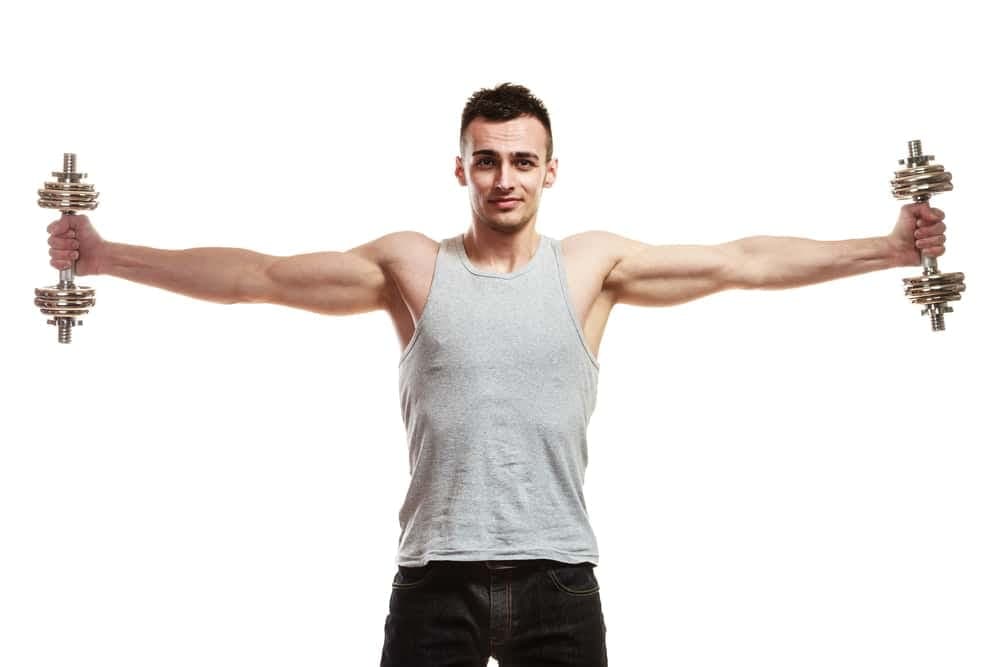6 Top Best Chest Isolation Exercises: Grow Your Chest Fast
Learn about the best chest isolation exercises to develop larger chest muscles on your biceps. Get 6 exercises to target your pectoral muscles for growth.
Beach season is on its way and getting a massive chest should be on your bucket list if you plan to show up with your best body yet. Chest isolation exercises can help you achieve this goal.
They’ll give you the means to build strength, power and definition in your chest muscles (aka your pectoral muscles or “pecs”).
So what are the best chest isolation exercises for a strong chest? The dumbbell chest fly, pec deck machine, low cable fly, dumbbell pullover, cable crossover, and machine chest fly are 6 of the best moves to isolate your chest muscles.
This article will help you get familiar with isolation vs. compound chest exercises. We’ll break down the benefits of isolation work.
Here, we’ll help you consider how to incorporate isolation into your workout routine.
What are the 6 best chest isolation exercises?
No matter where you look, you’ve definitely seen these top exercises chest isolation exercises listed as the best to grow your chest.
How do you do chest isolation?
To build a massive chest and make the type of gains that will give you an insane beach body, read on for a how-to on key chest isolation moves. If you work out for aesthetics or for strength and power, these key exercises are the perfect jumping-off point to build a solid chest.
Dumbbell Chest Fly
This is one of the best chest workouts with dumbbells to help grow your pecs. To start:
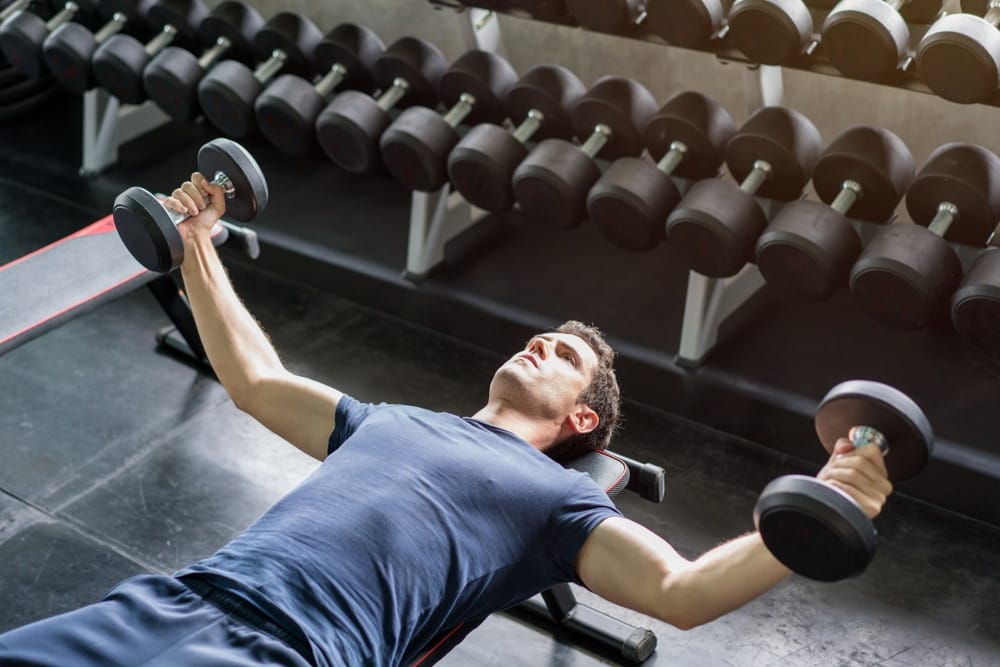
- Set-Up: Lie down on a flat weight bench, holding a light to medium-weight dumbbell in each hand.
- Body Position: Plant your feet firmly on the ground to the sides of your bench. Keep your back flush with the bench, trying not to arch.
- Fly: Lift your arms overhead so they are fully extended. Don’t lock your elbows out. Slowly separate your arms and lower them to your sides until they come to a parallel position with the floor. Don’t drop your arms below the height of your bench. Keep your chest and core muscles engaged as you move.
- Reverse: Exhale and slowly press your dumbbells back up in the same arcing movement to return to the starting position.
- Reps: Perform this move for 3 sets of 10-12 reps.
Pec Deck Machine
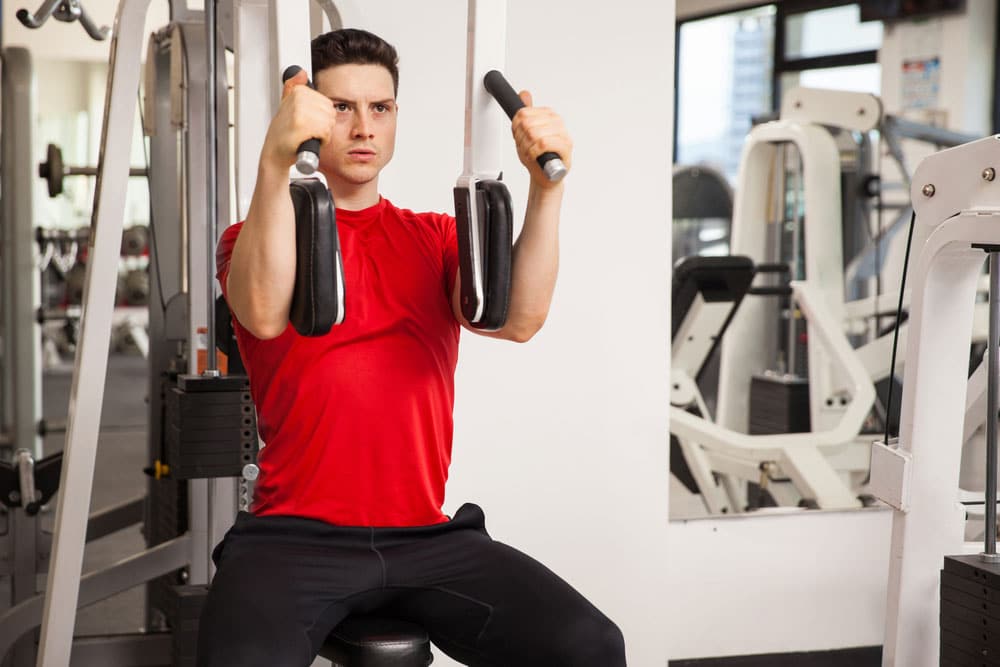
- Set-Up: Take a seat on your pec deck machine, planting your feet on the ground. Set your back up firmly against the back pad. Load a comfortable weight onto the weight stack. Line your forearms up with the arm pads, bringing your elbows to a 90-degree bend. Grasp the support handles.
- Action: Engaging your chest muscles, pull the machine’s handles in towards each other, bringing your arms closer together and contracting your pecs.
- Reverse: Hold for a moment, then resist your weight and slowly let your arms travel apart with control so they move back to the starting position.
- Reps: Repeat as needed. Generally, 3 sets of anywhere between 10-20 reps is good, depending on the weight you choose.
Low Cable Fly

- Set-Up: For this exercise, you’ll need two cable pulleys. Set your cable pulley attachments to the lowest setting on your cable towers. Use a D-handle attachment or any other handle that’s comfy in one hand.
- Body Position: Grab one handle in each hand, using an underhand grip so your palms face up and away from you. Move forward a few steps just enough so that you take the slack out of your cables.
- Fly: With a slight bend in your elbows, pull your handles towards each other so they come together near your mid-chest.
- Reverse: Hold for a moment and resist your weight, letting your arms come back to the starting position.
- Reps: Try this move for 3-4 sets of 8-15 reps, weight depending.
Dumbbell Pullover
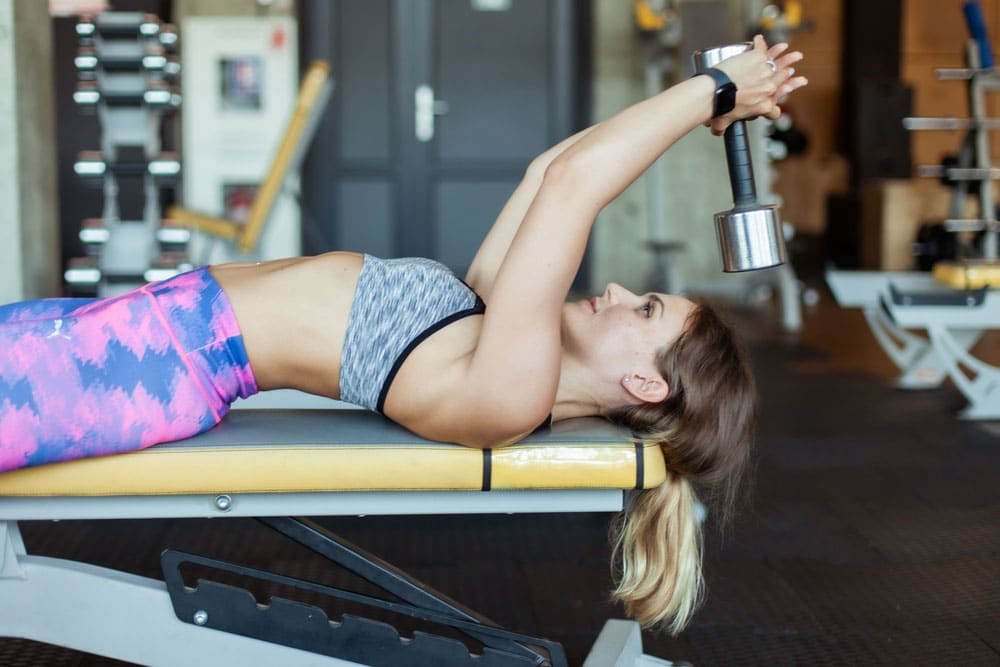
Depending on how you work this move, it can be more chest-dominant or more back-dominant.
The key to keeping the effort in your chest to isolate during your pullover is to work with a smaller range of motion.
When you let your dumbbell drop beyond the back of your head, the work transfers to your lats (back). Keeping your range small concentrates the effort in your pectoral (chest muscles). Although technically this is a compound exercise, working at this move using a reduced range of motion works effectively to isolate your chest muscles.
- Set-Up: Lie flat on your back on a weight bench. Plant your feet comfortably on the floor. Grab a single heavy dumbbell, wrapping both hands around one end and lifting it above your chest.
- Pullover: Keeping your arms extended with a slight bend, slowly pull both arms back, letting the weight drop back towards your head. Do not let your arms go lower than your weight bench. This range of motion helps keep the work in your chest.
- Reverse: Bring your arms back up and overhead, engaging your pectorals to drive the movement.
- Reps: Continue for 3-4 sets of 6-12 reps, depending on your weight.
Cable Crossover
Cable crossovers (aka, cable cross-overs or cable cross overs) are one of the most in-demand moves for growing a big chest.
-
- Set-Up: For this exercise, you’ll need two cable pulleys. Set your cable pulley attachments to shoulder height or a bit higher on your cable towers. Use a D-handle attachment or any other handle that’s comfy in one hand.
- Body Position: Grab one handle in each hand, using an underhand grip so your palms face up and away from you. Move forward a few steps just enough so that you take the slack out of your cables.
- Fly: With a slight bend in your elbows, pull your handles towards each other so they come together near your mid-chest.
- Reverse: Squeeze your chest muscles and hold for a moment. Resist your weight, letting your arms come back to the starting position.
- Reps: Try this move for 3-4 sets of 8-15 reps, weight depending on whether you’re working towards strength or hypertrophy (muscle growth).
Machine Chest Fly
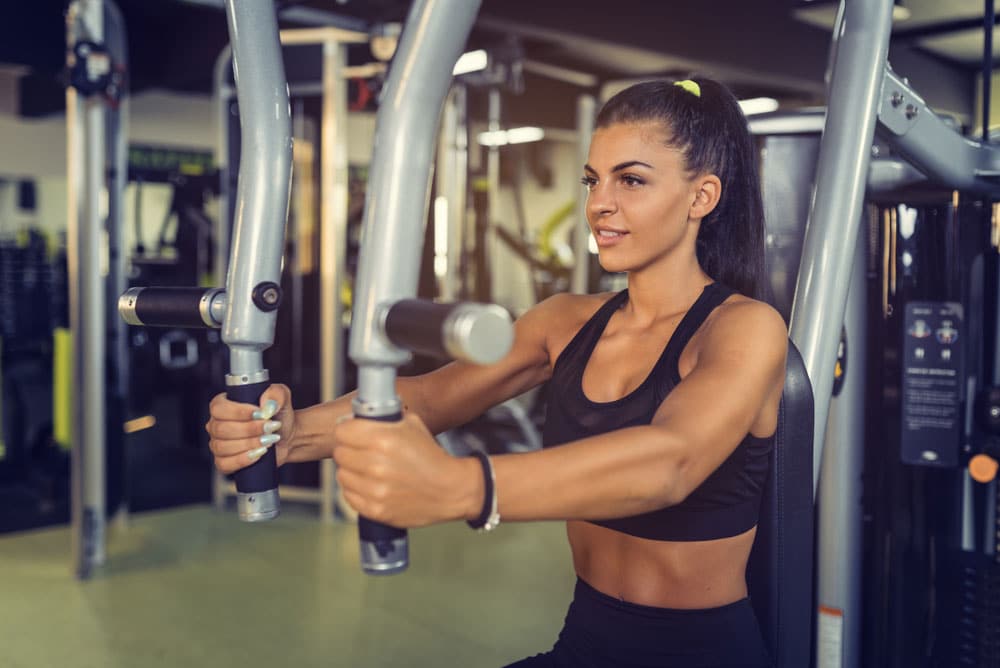
This move is similar to the pec deck only with straighter arms. For the machine chest fly:
- Set-Up: Take a seat on your chest fly machine, planting your feet on the ground. Set your back up firmly against the back pad. Load a comfortable weight onto the weight stack. Grasp the side grip handles.
- Action: Engaging your chest muscles, pull the machine’s handles in towards each other, bringing your arms closer together and contracting your pecs.
- Reverse: Hold for a moment, then resist your weight and slowly let your arms travel apart with control so they move back to the starting position.
- Reps: Repeat as needed. Generally, 3 sets of anywhere between 10-20 reps are good, depending on the weight you choose.
What is the difference between chest compound and isolation exercises?
A compound exercise works across multiple muscle groups and joints. These are often your big, heavy structural lifts.
Squats, deadlifts, and bench presses are all examples of this.
In terms of compound chest exercises, bench presses and push-ups are probably the most obvious examples. You can vary these moves too.
If you want to do an incline bench press or a diamond push-up, these push-up and bench press variations would still fall under the “compound chest exercises” category.
Benefits of chest isolation exercises
- Good form of post-injury rehabilitation
- Help correct muscle imbalances
- Help you to focus on better form
Benefits of compound chest exercises
- Better for building overall strength
- More functional exercises (These simulate moves you perform in your everyday life)
- Better for athletic performance
- Improves joint health
Isolation moves on the other hand work across a single joint. A study on Resistance Training with Single vs. Multi-joint Exercises found that using both types of exercise is beneficial.
Improving overall fitness, though, was best done by focusing on multi-joint (compound) exercises. Make sure to incorporate both these workout styles into your training.
Are compound or isolation exercises better?
You need to do both compound and isolation exercises for a well-rounded workout.
Structuring your workouts with both types of exercise depends on your time constraints and which weights you plan to use.
As a general rule, start with compound exercises and use isolation exercises as finishers.
If you’re struggling to grow one specific muscle or muscle group, using isolation work can be a great way to break through plateaus in your fitness routine.
When should you do compound vs. isolation chest exercises?
Compound exercises help you to achieve more strength and hypertrophy (growth) overall.
On the other hand, isolation moves help you to single out certain muscles that might be weaker, slow to grow, or have imbalances.
This can help you to catch a weak muscle group up to the rest of your body.
What are your chest muscles?
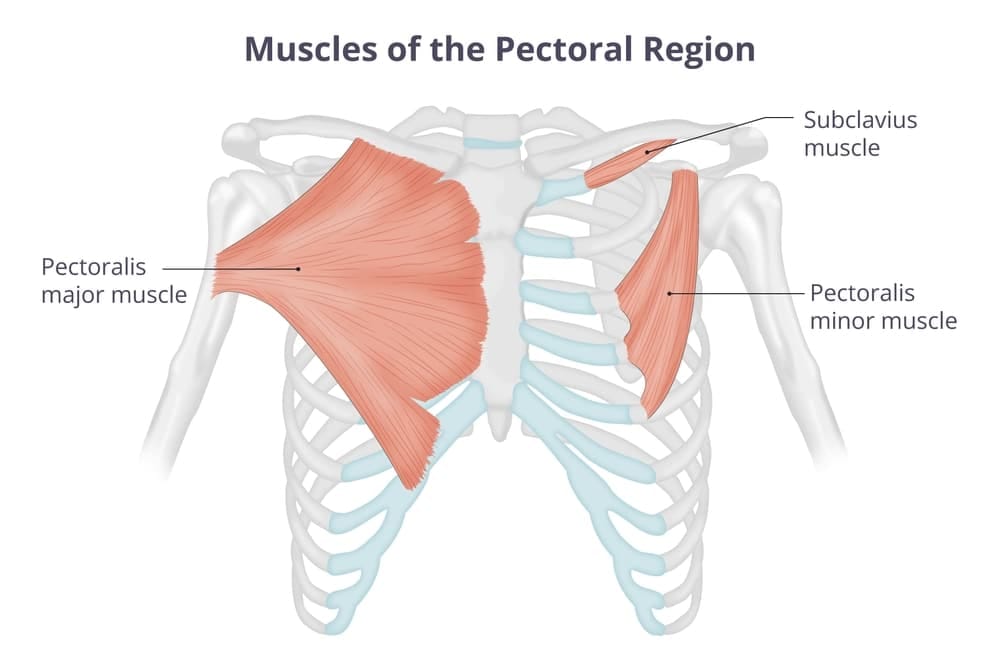
Your chest muscles are also called the pectoral muscles, aka “pecs.” The main muscles of your chest are large, fan-shaped muscles called the pectoralis major. The pecs attach to your upper arm bones (humerus bones), span across the top of your chest at your collarbones (clavicles) and attach to your sternum, the bone in the middle of your chest.
These muscles help you move your arms across your body and up and down.
Other chest muscles include:
- Pectoralis minor
- Serratus anterior
- Subclavius
Upper chest isolation exercises
For upper chest isolation exercises, focus on moves that work your pecs on an incline. Although these are technically compound lifts (meaning they work across multiple joints), for the sake of getting you the results you want, these moves do hone in on the upper pectoral region.
You can try moves like:
- Incline bench press
- Incline dumbbell press
- Overhead shoulder press
Lower chest isolation exercises
On the other hand, if you see slow growth in your lower pecs, you need to work on the opposite technique.
We saw that upper chest isolation works best by using an incline for your weight bench.
To work the lower pecs, try pulling the lever and dropping your weight bench to a decline. This can help you hit and grow a stubborn lower chest. Choose moves like:
- Decline bench press
- Decline dumbbell fly
- Dips
- Assisted dips
Should I isolate my chest?
It’s not as crucial to isolate your chest as it is to do compounds chest exercises that will help your pectoral muscles develop strength and power.
If you notice your chest isn’t growing as fast as the rest of your body, though, it may be a good idea. Chest isolation exercises can also be good if you have shoulder pain or elbow pain.
Many compound exercises (like push-ups or dips) work across all these joints. Chest isolation exercises can let you work your chest muscles with less strain on other joints.
How can I train my chest without a machine?

If you don’t have access to cable pulleys or even dumbbells, you can still work on chest isolation exercises at home!
Push-ups (aka pushups) are some of the best chest isolation exercises at home that you can do.
For more effectiveness, try different push-up variations to target and grow your chest. Like with the bench press, you can do:
- Incline push-ups
- Decline push-ups
You can get creative with your push-up hand placements too. For alternative push-up variations, try out:
- Diamond push-ups
- Wide arm push-ups
- Narrow push-ups
- Kneeling push-ups
Some calisthenics athletes even perform training routines using 100 pushups a day or 500 pushups a day!
It’s not for everyone.
But if you don’t have an at-home gym, it’s a great way to get started on growing your chest with chest isolation exercises. Want more advice on training your chest? These resources may help:
- 5 Best Inner Chest Exercises
- Chest Warm Up
- How Many Chest Exercises Per Workout?
- Bad Chest Genetics
Isolate your workouts for greatness. The Flex App progresses as you do with plate tracking capabilities and auto progression.
References
Krzysztofik, M., Wilk, M., Wojdała, G., & Gołaś, A. (2019). Maximizing Muscle Hypertrophy: A Systematic Review of Advanced Resistance Training Techniques and Methods. International journal of environmental research and public health, 16(24), 4897. https://doi.org/10.3390/ijerph16244897
Paoli, A., Gentil, P., Moro, T., Marcolin, G., & Bianco, A. (2017). Resistance Training with Single vs. Multi-joint Exercises at Equal Total Load Volume: Effects on Body Composition, Cardiorespiratory Fitness, and Muscle Strength. Frontiers in physiology, 8, 1105. https://doi.org/10.3389/fphys.2017.01105
Related articles


Get fit with Flex
Build muscle & lose weight fast for free.
Available on iPhone + Apple Watch
